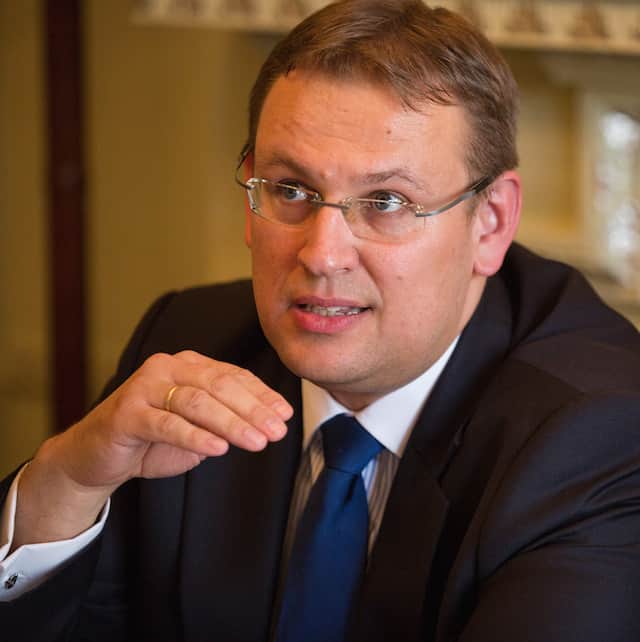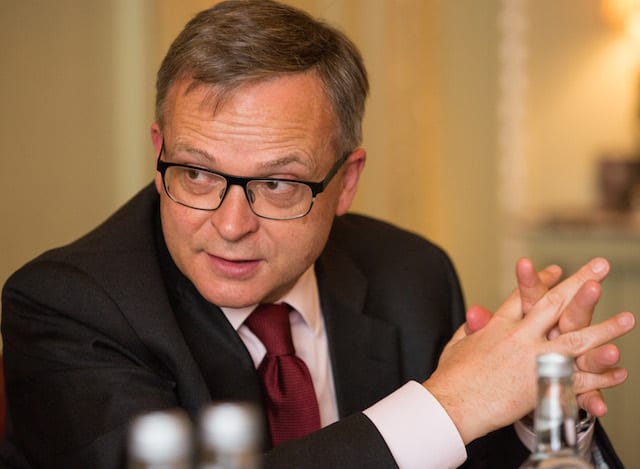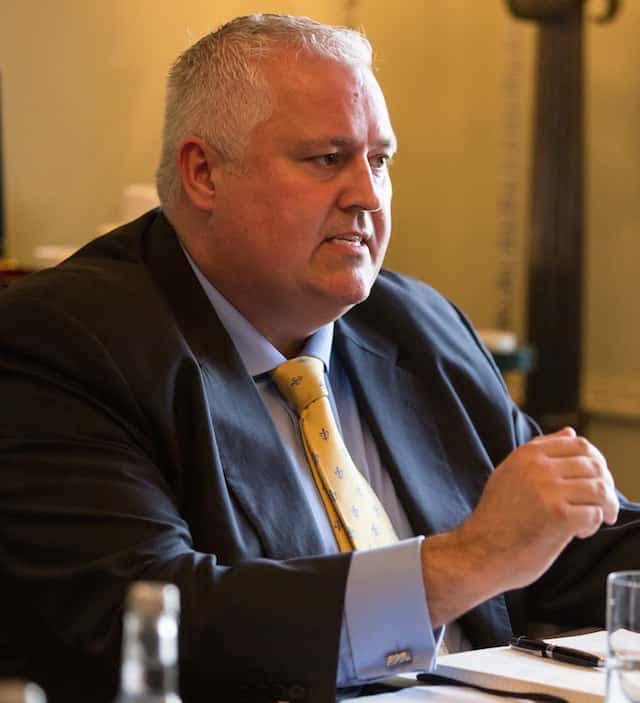SPONSORED ROUNDTABLE: SUBCUSTODY

Global Finance gathered executives in London for its annual subcustody roundtable. Participants focused on the impact of new European regulations on subcustodial banks, outsourcing and how technology is affecting the market.
Moderated By Joseph Giarraputo
Global Finance: European subcustody is being shaped by a series of recent regulations, including T2S [Target2-Securities—the new European settlement engine], T+2 [transaction-date-plus-two-days for equities trade settlement—the new standard in developed markets] and the EU’s Alternative Investment Fund Managers Directive [AIFMD] and UCITS V [Undertakings for the collective investment in transferable securities—the EU directive creating a harmonized legal framework for investment funds]. Tell us how you expect them to affect you and your customers.
Thomas Grajewski, UniCredit: I would group them in two categories in terms of the objective. T2S and T+2 are focusing on better settlement and cost efficiency, while AIFMD and UCITS V are about investor protection.
The first two require, especially T2S, a huge involvement from subcustodians and their clients, and also from the CSDs [central securities depositories] and ICSDs [International CSDs]. The project cannot proceed without engagement of central banks and regulators either. The latter regulations will be challenging not least because they eat up a lot of legal resources to shape the contracts at every level of the value chain—including the investor, fund, global custodian and finally subcustodian.
However, these regulatory changes are imposing much more thorough monitoring of both one’s contractual partners and CSDs. Deeper due diligence will be now essential to comply with high standard of care, and this will have to be done not only by us, subcustodian vis-a-vis CSDs, but also global custodians, prime brokers and their agents. The cost of this cannot be easily quantified, but I’m sure that globally we are talking about millions of euros.
T2S without doubt will bring efficiency in terms of settlement, as you will be able to settle many markets from one place by plugging in to this platform. However, at the same time asset servicing and liquidity will be separated from the settlement part, which will create new types of services. There is also cost and some risk attached to it.
Alan Cameron, BNP Paribas Securities Services: It should be more secure as settlement will be in central bank money and the system has been designed and built to be very robust. We certainly see increasing harmonization for settlement coming in as a result. It hasn’t really done as much for asset servicing. It’s really on costs that the big questions remain.
T2S raised expectations by announcing a $0.15 settlement fee. But that was only a “headline” rate which doesn’t include all the communication, matching and reporting charges. So the real T2S settlement fee is probably more like $0.25 to $0.35 and then you have to add the CSD fees. So if you want to get reduced costs from T2S, it’s not really a question of what T2S will do for you, but more about how you can simply processing as a result of T2S.
Rob Scott, Commerzbank: There’s obviously a lot more scrutiny on the subcustodian provider that is putting a lot of strain on the way the custodians are evaluated and reviewed. Local providers may not be around for long.
Cameron: T+2 is simply about decreasing pre-settlement risk. By cutting the settlement period from three to two days you get rid of a third of your pre-settlement risks. Everyone thinks that’s a good thing. It will then have a knock-on effect of reducing the collateral required. It brings all the markets together and then ties in with the FX markets. What is a bit worrying is that it’s happening very quickly. A lot of work has to take place on the buy side for it to go through correctly. We need to see affirmations automated. We need settlement instructions to be sent no later than T+1.
Grajewski: T+2 is about liquidity. One of the objectives is to shorten the time from an investor’s decision to buy/sell securities till the moment securities/sales proceeds are at the disposal of the investor. For the global custodians, brokers and subcustodians it will mean that liquidity provision must be taken care of much earlier than it has been so far. For bigger players and large markets, this should not be a big issue, provided that a market provides appropriate FX facilities, which will fund the account within one day from the trade date.
Scott: There’s still a long way to go for a number of counterparties, because it does necessitate a huge acceleration, in some cases, of the various processes around settlement, matching, confirmation—the whole lot.
Cameron: The buy side is now faced with a situation where the underlying equities that a fund may invest in will be out of step with redemptions and new money going into funds. It may well be that fund managers will expect their brokers to just carry everything to bridge this difference. So that would certainly puts a lot of pressure on funding.
Scott: Custodians are in the dark; they can’t price until they know what they’re going to get charged.
GF: T2S will be launched in four waves, the first of which is scheduled for June 2015. What does this mean?
Cameron: We have all got to be ready. That means now looking at the changes that will effect the settlement day, matching, partialling, linking, prioritization and with the introduction of “hold and release.” Without information on the pricing, it’s very hard for anyone to make radical decisions about changing dramatically their post-trade model.
Scott: There will be a lot of lessons learned as clients move forward. You have to be ready for some of the changes, new pricing and matching criteria, but because it is phased over many markets over many years you can introduce change in a very efficient way. However, you certainly have to be ready to support clients who want to go into wave one, two, three or four.
Grajewski: We will be ready for wave one as Romania is one of our core markets, but we are not expecting any real volume through their link as it is limited to euro-denominated settlements. But it is going to be a valuable experience which will stand us in good stead as we prepare for the first of our larger markets, Austria, to enter in 2016.
GF: The regulatory changes make increased demands on custodians and expose them to greater risk. How will this be reflected in business models?
Cameron: What’s happening is a continuation of what we’ve seen over the last 15 years or so, with the expense of being a subcustodian continuing to increase. The required investment in technology and regulatory oversight is huge, and it’s a business that less and less banks can afford. At the same time, our clients are under huge pressure because their models have had a very testing time over the last few years. So the key thing is to ensure that we use harmonization to simplify processing and drive down our costs. The key is not to centralize too quickly and to keep the local processing and knowledge and expertise that you need. The custodians will need to offer bundled and unbundled services.
Grajewski: I would rather say that these changes will affect not only subcustodians but other players, like global custodians and global investment firms. For subcustodians, this will lead to more consolidated business models, a sort of hub solution (eg T2S), further decreased margins and increased cost of operations (T2S and AIFMD), and more unbundled service propositions, which may partially compensate the delta derived from lower margins and cost increases. Changes will affect account structures, operating models—for example, liability changes may promote operator models for global custodians or their clients—and also service models under T2S.
Scott: Subcustody has to be a lot more efficient than it has been. Think about many of the systems that underpin the global custodians or even the subcustodians. It is like trying to change the course of a large tanker sometimes. So people who can be very nimble and efficient will be the winners. Some organizations may been be driven out of business, simply because servicing regulatory change along with being local and adopting multiple technologies in different countries is going to be cost prohibitive.
GF: The Ukraine continues to be in the midst of a political and military storm. How has this affected operations there?
Grajewski: For me any market where this kind of storm exists leads to one conclusion: Business continuity and recovery is not just nice to have but it is essential to be properly secured in emergency events—not only our own franchise but especially the clients’ business, which we are accountable for. This obligation also lies on CSDs, central banks and stock markets, so close cooperation between all these institutions and regular BCP testing is essential.
Scott: It is understanding what you are doing in that market and making sure that you really understand it, that you can adapt to any situation, that you have a good disaster recovery plan in place so clients have a high level of comfort and can leverage their assets along with gaining access to them.
GF: Will consolidation continue? And how far will it proceed?
Cameron: Over the last few years when volumes and asset valuations declined, a lot of businesses discovered that a lot of their costs weren’t marginal but fixed. These institutions have very much questioned whether they should stay in a whole array of products, custody being one of them. There are a number of banks that probably wish they had sold their businesses a few years ago and would quite like to sell them today. The question is whether anyone will buy them. From a client’s point of view, it makes every sense to ensure that you’re with a bank that sees a future in this business and will continue to invest in it. In Western Europe there’s probably only room for two or three big subcustodians.
Scott: Many of the big players have created a kind of factory approach. I am seeing pushback from clients who don’t necessarily want something straight off the production line. There are some who definitely want standardization, but every counterparty has a different back office, middle office and connectivity, technology and interface. There is still a need for providers who can drive local innovation and who are very well connected. What I hear from clients is that the large organizations with highly credible people and great presentations are not once asking what their problems are.
Grajewski: In my view this is just another stop in a long journey which our industry began a decade ago. There are still single market providers, which in the long-term may have difficulties to continue with subcustody services, especially as there will be more and more obligations imposed on subcustodians, while the path for margin level seems to be only one way. The next stop will be experienced after T2S is in place, as naturally many banks will have to think through their strategies and decide whether they can afford to continue subcustody services or not. Only large players with economies of scale will be strong enough to do it. However, in the meantime, you could see, at least in my region, some new entrants—not totally new players in this industry but the same players entering new countries. Will it be sustainable? Let’s see…
GF: Custodians have been offering outsourcing services to clients for years. They have had some success signing up smaller broker-dealers. What are the prospects of large broker-dealers following the trend?
Scott: They have got these platforms and either they are hugely expensive in most cases or they are hugely inefficient, and that is driving significant pressure to cut costs. Meaning that if on the front-office side you can’t increase your revenues and you continue to get margin compression—something has to give. If you look at some organizations, particularly the larger organizations, the cost of their IT operations is prohibitive. I do see that outsourcing over the next three-to-five years will be very significant.
If you look at the operations of what we all do, particularly in security settlement, it is very commoditized. Whether that trend gets sucked up by the big custodians, it remains to be seen.
Grajewski: The idea of a major broker outsourcing the entirety of its post-trade (and even more) operations to a third party is technically feasible but realistically unlikely. However, we do expect a continued trend of component-based outsourcing where parts of the broker processing is outsourced. We already see this in our region in remote brokerage with the operator model. The advent of CCPs will lead to local opportunity for collateral management alongside management of the global collateral pool of the brokers, and we see growing demand for local currency liquidity provision.
Cameron: This has been focused on the mid-tier. They’re getting an immediate benefit in outsourcing from a high-cost center to a company performing the tasks in, generally speaking, a low-cost environment. Plus the mid-tier brokers have been under incredible cost pressure over the last few years, so they were willing to look at very radical responses. For the top tier, I’m not sure that these two things are so compelling, but we have seen a number of them look at it.
GF: How is the market for collateral management services developing, and how are new regulations affecting it?
Cameron: Clients want the most out of their collateral 24 hours a day, rather than using a piece for only one or two hours. We’ve changed our own systems so that we can measure more accurately what is in our client’s accounts to give them credit and cash against their holdings. That was done, one, to make us feel more comfortable with our credit decisions, but also to serve clients who nowadays have to show their regulators that the credit they receive is based upon something other than the goodwill of the bank. The biggest change for us has been bringing in our improved measurements of what collateral we hold ourselves. Regulators want to see clients have a capital buffer against the credit facilities they receive, and the fact that the banks providing you with this credit are doing so on the basis of security and collateral may decrease the amount of capital the clients have to put up. This measurement of the collateral that is with you has become absolutely crucial.
Scott: Collateral management, I’ve been saying for years, is king. Anyone who can get this right will have a very healthy client base going forward. The ability to cross-margin across jurisdiction, across product, is very important. Helping clients understand their collateral obligations and how to shape them is one of the benefits of investment banking coming together with transaction banking. Banks that have gone through their own challenges since the crisis have got a better understanding of how to manage their balance sheet, the credit valuation adjustment, assets, how collateral affects everything. We’re definitely seeing an increase in advisory function around that.
GF: Is good collateral management reliant on software or procedures?
Scott: There are people around that understand collateral very well: they know what’s cheapest to deliver, have good valuation tools and are able to put that into an optimization program and spit out a result and manage that on behalf of the client. So it’s not a particular piece of software but an understanding of how collateral works and the relative value of one collateral against another.
GF: How will the European subcustody sector look in five years?
Grajewski: This industry is on the road to new technology, optimization and efficiency, which is a natural path to growth and improvement. This is also the way for all of us to shape the future. We are still going to face challenges in developments to the trading, regulatory and infrastructure environment. However, what is key about this industry is that we still see the same faces. Maybe not in the same companies, because some of the banks do not provide subcustody services anymore or some custodian banks outsource the business to global custodians. But the close ties between custody fellows are still very strong.
Scott: I would expect there to be fewer providers than there are currently. The way custodians and subcustodians traditionally make their money has to change. I hope there is a better understanding from clients, because for the last 10 years it has only been about price, price, price.. It’s now come to the point where people are going to be charged for different services around the risk that subcustodians will take. There is going to be continued integration of the big investment banks with their investor service custody businesses. They’re going to be more advisory and solution-oriented going forward. I would still like to see local custodians around because, once we’ve only got two or three providers, you begin to lose innovation, you start to lose the connectivity to the local environment.
Cameron: Sadly, we will be dealing with a more complicated post-trade landscape, especially if CSDs are given a favorable regulatory environment. We won’t see the consolidation we badly need. We will see settlement harmonized and provided through international operating centers and asset servicing still spread across local markets. We will see services offered on both a bundled and unbundled basis, and it will continue to be a relationship business. But credit and liquidity will absolutely be key in deciding who your partners are going to be.






